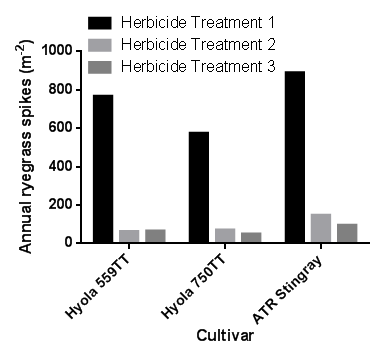Managing Clethodim resistant ryegrass
Author: Assoc Prof. Christopher Preston, University of Adelaide | Date: 29 Feb 2016
Managing Clethodim Resistant Annual Ryegrass
Christopher Preston, Samuel Kleemann and Gurjeet Gill, School of Agriculture, Food & Wine, University of Adelaide
Key messages
-
Extensive clethodim resistance in annual ryegrass across southern Australia is making management of this weed species difficult in canola.
-
The competition provided by hybrid canola cultivars offers an opportunity to reduce annual ryegrass seed set by about 50% compared to open-pollinated cultivars.
-
RT canola offers additional options for the control of clethodim resistant annual ryegrass in the canola phase of rotations. This is particularly important where pre-emergent herbicides are the only effective option for the wheat phase.
Aims
Clethodim is an important herbicide for the management of annual ryegrass in canola. As a result of the extensive resistance to other post-emergent herbicides, clethodim has become the last herbicide for control of annual ryegrass in conventional canola. Resistance to clethodim in annual ryegrass has been increasing across Australia in recent years (Boutsalis et al. 2012, Owen et al. 2014), which has made management of annual ryegrass in canola more difficult.
Herbicide tolerance is an important feature of canola production in Australia, with three herbicide tolerance systems to choose from: triazine tolerant (TT), Clearfield (CF) and Roundup Raedy (RR). However, each of these systems has weaknesses in the management of annual ryegrass. Atrazine is relatively weak on grasses, so clethodim is routinely used in TT canola for annual ryegrass control. There is widespread resistance to the imidazolinone herbicides in annual ryegrass making CF system ineffective in many regions. RoundupReady herbicide can only be applied up to the 6-leaf stage in RR canola and this can lead to survival of later emerging annual ryegrass, particularly in higher rainfall regions.
To address the problem of managing clethodim resistance in annual ryegrass, we have been conducting both short and long-term trials to develop alternative management practices. In the absence of post-emergent herbicides, the use of pre-emergent herbicides alone is insufficient to effectively manage annual ryegrass (Saini et al. 2015, 2016). However, crop competition in conjunction with pre-emergent herbicides can reduce annual ryegrass seed set significantly. The recent introduction of RT canola, resistant to both triazines and glyphosate, offers additional opportunities for managing annual ryegrass in canola.
Method
Suppression of annual ryegrass seed production through crop competition
A trial was conducted at Roseworthy, SA in 2015 to examine the role of more competitive cultivars in reducing annual ryegrass seed set. The trial examined three TT canola cultivars ATR Stingray (open-pollinated), Hyola 559TT (a hybrid) and Hyola 750TT (a high biomass hybrid). The trial was sown on 15 May 2015 with a target population of 35 plants m-2.
There were three herbicide management strategies employed: Herbicide Treatment 1 - no herbicides; Herbicide Treatment 2 - Atrazine (1.5 kg ha-1) pre + Clethodim (500 mL ha-1) post; and Herbicide Treatment 3 - Rustler (1 L ha-1) pre + Clethodim (500 mL ha-1) + Factor (80 g ha-1) + Atrazine (1.1 kg ha-1) post. Weed counts were made 28 days after sowing, 28 days after post emergent herbicide application and at maturity. Plots were harvested on 12 November.
Annual ryegrass weed counts and spike counts were square-root transformed to improve the distribution and subjected to two-way ANOVA with cultivar and herbicide treatments as factors. Both were significant. Canola yield was also subjected to two-way ANOVA with cultivar and herbicide treatments as factors. Again both were significant.
Strategies for better management of annual ryegrass using RT canola
A long-term trial on management of herbicide resistant annual ryegrass was started at Lake Bolac, Vic in 2012 comparing cultural management practices for annual ryegrass. These failed to control annual ryegrass and were discontinued. The site was sown to RT canola in 2014. Hyola 525RT was sown on 20 May 2014 and three herbicide management strategies imposed: low; medium; and high intensity management (Table 1). In 2015, Beaufort wheat was sown on 14 April. Weed counts were made 30 days after sowing, 30 days after any post-emergent herbicide applications and at maturity in each year.
Annual ryegrass weed counts and spike counts were square-root transformed to improve the distribution and subjected to two-way ANOVA with prior cultural practices and herbicide treatments as factors. There was no significant effect of prior cultural practices, so data were pooled.
Table 1. Weed management strategies used at Lake Bolac trial site in 2014 and 2015
|
Management strategy |
Canola phase 2014 |
Wheat phase 2015 |
|
Low intensity |
Trifluralin (3 L ha-1) + Atrazine (2.2 kg ha-1) pre Clethodim (500 mL ha-1) post |
Trifluralin (3 L ha-1) + Avadex Xtra (2 L ha-1) + Dual Gold (250 mL ha-1) pre
|
|
Medium intensity |
Trifluralin (3 L ha-1) pre RoundupReady (900 g ha-1) cotyledon stage RoundupReady (900 g ha-1) + Atrazine (1.1 kg ha-1) 6 leaf stage |
Sakura (118 g ha-1) pre |
|
High intensity |
Rustler (1 L ha-1) pre RoundupReady (900 g ha-1) cotyledon stage RoundupReady (900 g ha-1) + Atrazine (1.1 kg ha-1) 6 leaf stage Weedmaster DST (2.5 L ha-1) crop top |
Sakura (118 g ha-1) + Avadex Xtra (2 L ha-1) pre Boxer Gold (2.5 L ha-1) early post |
Results
Suppression of annual ryegrass seed production through crop competition
In this trial there was a significant effect of both cultivar (p <0.0001) and herbicide treatment (p <0.0001) on the number of annual ryegrass spikes present at maturity. The annual ryegrass population at the site was resistant to clethodim, so post-emergent treatments were not very effective. The high biomass canola (Hyola 750TT) significantly reduced the number of annual ryegrass spikes at harvest compared to the other two cultivars in the absence of herbicides (Herbicide Treatment 1), demonstrating the impact of extra competition provided by this cultivar (Figure 1). Where Herbicide Treatments 2 and 3 were employed (Figure 1), there was about twice the number of annual ryegrass spikes at maturity in the ATR Stingray plots compared with the two hybrid cultivars. Simply changing from an open-pollinated cultivar to a hybrid canola has the potential to reduce annual ryegrass seed set by half.
South Australia experienced a hot and dry spring during 2015, so canola yields in this trial were low. The early finish to the season did not suit the longer season cultivars and in addition yield of Hyola 750TT was affected by frost. There were significant effects of cultivar (p = 0.042) and herbicide treatment (p <0.001) on canola yield; however, the highest yield was only 1.17 T ha-1 for Hyola 559TT with Herbicide Treatment 3 (data not shown).

Figure 1. Effect of canola cultivar and herbicide treatment on annual ryegrass spike numbers at maturity at Roseworthy in 2015. Herbicide Treatment 1: no herbicides; Herbicide Treatment 2: Atrazine (1.5 kg ha-1) pre + Clethodim (500 mL ha-1) post; and Herbicide Treatment 3: Rustler (1 L ha-1) pre + Clethodim (500 mL ha-1) + Factor (80 g ha-1) + Atrazine (1.1 kg ha-1) post.
Strategies for better management of annual ryegrass using RT canola
At the Lake Bolac site, the annual ryegrass was resistant to all post-emergent herbicides including clethodim. The high rainfall and long growing seasons at this site put pressure on pre-emergent herbicides. There was a significant effect of management strategy (P = 0.007) on annual ryegrass spike numbers at maturity in the RT canola phase. There were significantly fewer annual ryegrass spikes in the high intensity management treatment compared with the other two management strategies (Figure 2).

Figure 2. Effect of management strategy on annual ryegrass spike numbers at maturity at Lake Bolac in 2014 and 2015. RT canola was sown in 2014 and wheat in 2015. Management strategies are listed in Table 1. Different letters indicate significant differences between means among management strategies for each year.
In 2015, the number of annual ryegrass spikes at maturity increased for all management strategies. This is the result of the pressure that pre-emergent herbicides come under in this environment. Despite this, the high intensity management strategy was able to reduce annual ryegrass spike numbers by 70% at the end of 2015 compared with the low intensity management and by 50% compared with the medium intensity management (Figure 2).
It is clear that in high rainfall areas that high intensity management of annual ryegrass is required every year just to prevent an increase in the annual ryegrass population. The ability to attack annual ryegrass at least three times during the canola phase was important for restricting the population size when only pre-emergent herbicides are available in cereals.
Conclusion
Clethodim resistance in annual ryegrass is making this weed problematic to control in canola crops. As many populations also have resistance to imidazolinone herbicides, control in both TT and CF canola is difficult. Consequently, there will be much greater reliance on pre-emergent herbicides for control of annual ryegrass in the future. Reliance on pre-emergent herbicides creates its own problems, due to risks of resistance developing, but also due to surviving annual ryegrass setting a lot of seed.
Hybrid and high vigour canola cultivars offer a simple opportunity to reduce annual ryegrass seed set by providing extra competition during the season. Switching from an open-pollinated cultivar to a hybrid can reduce annual ryegrass seed set by 50%. RT canola offers new opportunities for managing clethodim-resistant annual ryegrass in canola, by providing the ability to attack annual ryegrass multiple times.
It will be important to maintain effective control of annual ryegrass during the canola phase due to the lower number of weed management opportunities to control annual ryegrass in wheat. Pre-emergent herbicides, post-emergent herbicides, competition and seed set control will all be crucial in achieving this.
References
Boutsalis, P., Gill, G.S. and Preston, C., 2012. Incidence of herbicide resistance in rigid ryegrass (Lolium rigidum) across southeastern Australia. Weed Technology 26, 391-398.
Owen, M.J., Martinez, N.J. and Powles, S.B., 2014. Multiple herbicide‐resistant Lolium rigidum (annual ryegrass) now dominates across the Western Australian grain belt. Weed Research 54, 314-324.
Saini, R.K., Kleemann, S.G., Preston, C. and Gill, G.S., 2015. Control of clethodim-resistant Lolium rigidum (rigid ryegrass) in triazine-tolerant canola (Brassica napus L.) in southern Australia. Crop Protection 78, 99-105.
Saini, R.K., Kleemann, S., Preston, C. and Gill, G., 2016. Alternative herbicides for the control of clethodim-resistant rigid ryegrass (Lolium rigidum) in Clearfield® canola (Brassica napus L.) in southern Australia. Weed Technology, in press.
Key words
Canola, competition, pre-emergent herbicides, clethodim resistance, annual ryegrass
Acknowledgments
The authors would like to thank GRDC for financial support, collaborators at Southern Farming Systems and MacKillop Farm Management Group for hosting and managing long-term field trials and Pacific Seeds for providing canola seed and funding additional weed suppression and IWM trials.
GRDC Project Number: UCS00020
GRDC Project Code: GIA00004,
Was this page helpful?
YOUR FEEDBACK
